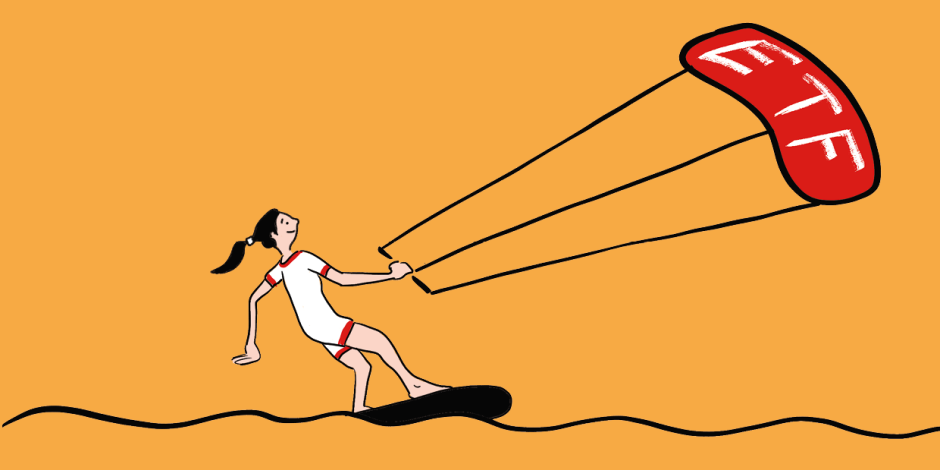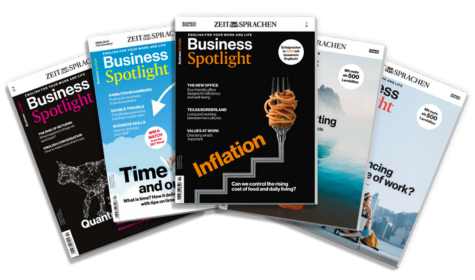Every era has its financial trends and, right now, everyone seems to be investing in exchange-traded fundbörsengehandelter Fondsexchange-traded funds (ETFs). The asset managementVermögensverwaltungasset management company BlackRock expects ETF investments on European digital platforms to reach half a trillionBilliontrillion euros by 2026. In Germany, the amount of money invested in ETFs rose by 254 per cent between 2019 and 2021. We explain the ABCshier: EinmaleinsABCs of ETFs: what they are, how they work, and the advantages and risks for investors.
WTF are ETFs?!
Exchange-traded funds are a type of index funds — in other words, they are collections of stockAktiestocks, bondAnleihebonds or other investments. Personal-finance consultant and journalist Eric Rosenberg says you can think of them as a basket of investments. Instead of investing in one individual assetAnlageasset, each with its own feeGebührfees and level of risk, you can invest in the basket. They differ from traditional investment funds, which are actively managed by professionals. ETFs are not run by fund managers, meaning lower fees and lower minimums to invest. Passive ETFs replicate sth.etw. nachbildenreplicate the performance of a broader equity marketAktienmarktequity market — the S&P 500, for example — or a specific sector or trend.
Both physical and synthetic ETFs exist, and it’s important to do researchRechercheresearch before investing. An example of a physical ETF is gold, which can be held in vaultTresorraumvaults on behalf ofim Auftrag vonon behalf of investors. A synthetic ETF is not based on a tangible goodmaterielles Guttangible good and does not invest in assets directly. A synthetic ETF tracks assets based on futuresTermingeschäftefutures contracts, for example. These are agreements with a third party, often an investment bank, who guarantees to pay back an agreed level of returnRenditereturn when the asset reaches a certain price. Ed Marshall, a British financial adviser, explains: “Physical can provide some security because at least the fund directly purchase sth.etw. erwerbenpurchases the underlyingzugrunde liegendunderlying stocks. Synthetic funds enter into a contract with a counterpartyGegenpartei, -seitecounterparty, and aim to match the performance of an index, without actually owning the underlying stocks. They come with greater risk, including exposureAusgesetztsein; hier: Risikoexposure to the counterparty defaultzahlungsunfähig werdendefaulting.” In 2022, investors were warned about synthetic sustainablenachhaltigsustainable ETFs, as some used pollutinghier: mit umweltschädlichem Verhaltenpolluting companies as collateralSicherheit(en)collateral, according to media reports, which angered investors who prioritize sustainability.
There’s an ideal ETF for just about every possible investment goal
“It feels like ESG [environmental, social and governanceFührung; hier: Unternehmensführunggovernance] has been around for decades, but the journey has just begun, and further market consensus, as well as regulatory initiatives, will shape the future for ESG-related products,” Detlef Glow, head of EMEA research at Refinitiv Lipper, told the Financial Times.
Increasingly, sustainable ETFs are chosen by ethically conscious investors hoping to generate returns without damaging the planet. The good news is that most sustainable ETFs generate better returns than other options, especially in Europe and North America, according to ISS Market Intelligence. One reason for this positive outlook is that companies with a sustainable focus tend to have a long-termlangfristiglong-term ESG policyRichtliniepolicy, and are less likely to be involved in risky or unethical practices that can damage reputation and performance.
Why invest?
ETFs offer flexibility, allowing investors to create portfolios that suit their preferences. It’s possible to invest in a specific sector, like health care or technology, or in something that’s close to one’s heart, such as sustainability or artificial intelligence. Investing in a range of portfolios creates diversificationVerteilungdiversification, which lowers the risk.
EFTs are easy to manage, and to buy and sell on an exchangehier: Börseexchange at low minimums. In some countries, they’re also more tax-efficient than other investments — as they’re traded less often than active funds, there are fewer capital gains and fewer tax liabilitiesSteuerverbindlichkeitentax liabilities.
Risks
As with any investment, there’s no guarantee of making a profit. fluctuationSchwankungFluctuation means you could lose money, and certain brokerage accountCourtage-, Maklerkontobrokerage accounts come with high trading fees. There’s also a liquidity risk — during periods of volatilevolatil, schwankendvolatile trading, it may be hard to sell funds quickly. Before investing, it is always wise to speak to a financial manager and a tax adviser.
How do I invest?
In 2023, the Deutsches Aktieninstitut found that only 17 per cent of Germans invest in shares or ETFs. To get started, here’s a step-by-step guide to shaping your investment portfolio:
1. Research
Nathanael Häfner, finance editorRedakteur(in)editor at DIE ZEIT, recommends using the Verbraucherzentrale, Finanztest, Finanztip and Finanzfluss to get an overview. “Finanztip and Finanzfluss earn commissionProvisioncommissions with affiliate linkHyper-, Partnerlinkaffiliate links, which you should be aware of,” he says. “As a rule, every portal advertises financial products or has its own interests. Investors should be careful. There is no quick way to get rich. As the old adageSpruch, Sprichwortadage says: ‘The higher the profit, the higher the risk.’”
Research the industry you want to invest in — particularly for ESG investments. Häfner says IT, finance and health care are popular sectors. Tech stars, like Nvidia, have seen their share priceAktienkursshare prices pushed up by AI (artificial intelligence)KI (künstliche Intelligenz)AI hype and are currently performing better than other sectors. “However, the market for tech companies is overheatedüberhitztoverheated and overvalued — this high could come to an end.”
Look at the past performance of the ETF you’re interested in, to make sure it’s not too risky. Also, review brokerBörsenmakler(in)brokers and trading platforms — some (but not all) charge fees for ETF trading.
2. The active part
Häfner says: “It’s more important to start than work sth. outetw. herausfindenwork out which ETF to choose in great detail. You shouldn’t have more than two savings plans. Private investors needn’t over-optimize — for example, 80 per cent in MSCI World or FTSE All-World [indicesPlural von „index“indices that track sth.hier: etw. abbildentrack the largest companies worldwide] is enough. What you mix in with the final 20 per cent is a matter of personal taste.”
Once you’ve selected a portfolio, you need a brokerage account. Some are available for free, with some German banks, and others are free via online brokers. Then, choose the amount you wish to invest each month. Some banks offer plans with €25 or €50 monthly, and some online brokers offer plans from as little as €1 a month. Consider the fees, however. Some banks offer free brokerage accounts but charge a flat feePauschalgebührflat fee of €10 to buy or sell, for example. At other banks, brokerage accounts are free only if you make at least one purchase per quarterQuartalquarter. Online brokers are often cheaper, but always read the small printKleingedrucktessmall print carefully.
3. In the long term
Robert Michaud, chief investment officerChief Investment Officer; etwa: Leiter(in) Investitionsstrategiechief investment officer at New Frontier Advisors, told TIME:“The future is too uncertain for a single securityWertpapiersecurity or asset class.” He recommends diversifying early to avoid having to change investment portfolios too often. Generally, experts say a diversified portfolio will serve you well for a long time, without the need for changes. Eric Rosenberg told Business Spotlight: “Most beginners should do plenty of research to ensuresicherstellenensure the ETFs they buy align sth. with sth.etw. auf etw. ausrichtenalign with their long-term investment goals, but they don’t need much additional maintenancePflege; hier: Verwaltungmaintenance once everything is be up and runninglaufen; hier: eingerichtet seinup and running. check inhier: eine Überprüfung durchführenChecking in every few months, or after major life events, should be often enough for the typical investor.”
Rosenberg says everyone should consider ETFs: “While I imagine there’s a situation where someone shouldn’t invest in ETFs, I can’t think of one myself. Because ETFs are so diverse, with many low-fee options, there’s likely an ideal ETF, or combination of ETFs, for just about every possible investment goal.”
INVESTMENT VOCABULARY
- appreciation: increase in the value of an assetVermögenswertasset
- brokerage account: investment account for managing assets
- capital gain: profit from the sale of an asset that has increased in value
- fill or kill: order to buy or sell that must be execute sth.etw. ausführenexecuted immediately (in seconds). Often used for large orders, so the price stays the same
- government bonds: bonds back sth.etw. (ab)sichernbacked by the government, so they’re generally safer
- high-yieldertragsstarkhigh-yield bonds: riskier bonds with more potential for profit or loss
- index fundFondsfund: investment fund that track sth.hier: etw. abbildentracks the returnRenditereturns of a market index, measuring the performance of assets such as stockAktiestocks or bonds
- mutual fund: portfolio of stocks or bonds, run by a professional fund manager
Neugierig auf mehr?
Dann nutzen Sie die Möglichkeit und stellen Sie sich Ihr optimales Abo ganz nach Ihren Wünschen zusammen.



